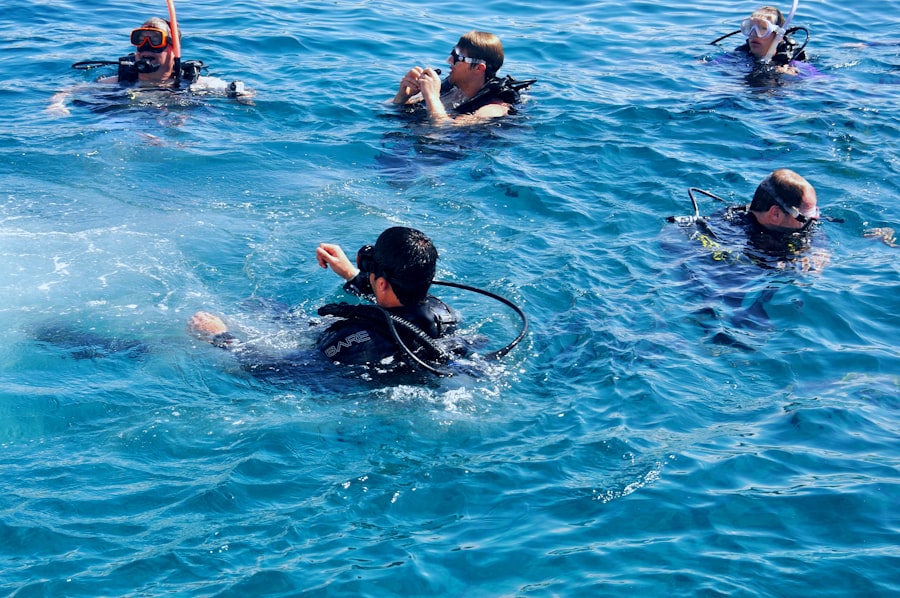Download links
How to install Exploring the Shallow Sea: A Beginner's Guide to Diving APK?
1. Tap the downloaded Exploring the Shallow Sea: A Beginner's Guide to Diving APK file.
2. Touch install.
3. Follow the steps on the screen.
Description
Scuba diving is an exhilarating underwater activity that allows individuals to explore the depths of oceans, lakes, and rivers while breathing underwater. The term “scuba” is an acronym for Self-Contained Underwater Breathing Apparatus, which refers to the equipment that divers use to breathe while submerged. The fundamental principle behind scuba diving is simple: divers use a tank filled with compressed air, which they can access through a regulator that delivers air at ambient pressure.
This enables them to experience the underwater world in a way that is both immersive and breathtaking. To begin scuba diving, one must first undergo training to understand the essential skills and safety protocols involved.
These courses cover a range of topics, including buoyancy control, equalization techniques, and emergency procedures. Additionally, divers learn about the physiological effects of pressure on the body, which is crucial for preventing conditions like decompression sickness. Understanding these basics not only enhances the diving experience but also ensures safety while exploring underwater environments.
Key Takeaways
- Scuba diving involves breathing underwater using a tank of compressed air and requires proper training and certification.
- Choosing the right gear and equipment is crucial for a safe and enjoyable diving experience, including a mask, fins, regulator, buoyancy control device, and wetsuit.
- Safety tips for diving in shallow waters include checking for hazards, maintaining proper buoyancy, and communicating with your dive buddy.
- Exploring marine life in shallow seas can be an amazing experience, but it’s important to respect the environment and avoid touching or disturbing the creatures.
- Navigating underwater terrain requires good buoyancy control, proper finning techniques, and using a compass or other navigation tools to avoid getting lost.
- Responsible diving practices for beginners include following the “leave no trace” principle, respecting marine life, and being mindful of your impact on the underwater environment.
Choosing the Right Gear and Equipment
Wetsuits and Drysuits: Thermal Protection and Insulation
For instance, a wetsuit provides thermal protection in warmer waters, while a drysuit is essential for colder environments, keeping divers insulated from frigid temperatures.
The Buoyancy Control Device (BCD): Maintaining Neutral Buoyancy
The buoyancy control device (BCD) is another critical piece of equipment that allows divers to maintain neutral buoyancy underwater. A well-fitted BCD not only provides comfort but also enables divers to manage their ascent and descent effectively.
Regulators and Fins: Efficient Breathing and Propulsion
The regulator is equally important; it must be reliable and easy to use, as it delivers air from the tank to the diver. When selecting fins, divers should consider their comfort and efficiency in the water. The right fins can significantly enhance propulsion and reduce fatigue during dives.
Ultimately, investing in quality gear tailored to individual preferences and diving conditions can greatly enhance the overall experience.
Safety Tips for Diving in Shallow Waters

Diving in shallow waters may seem less risky than deep-sea diving; however, it still requires adherence to safety protocols to ensure a safe experience. One of the primary safety tips is to always dive with a buddy. This practice not only enhances safety but also allows divers to share their experiences and assist each other in case of emergencies.
Establishing clear communication signals before entering the water is essential, as it helps both divers stay informed about each other’s status throughout the dive. Another critical aspect of shallow water diving safety is monitoring air supply.
Divers should regularly check their air gauges and maintain a conservative approach to air management.
Additionally, practicing controlled ascents is vital; even in shallow waters, rapid ascents can lead to barotrauma or decompression sickness. A slow ascent allows nitrogen to safely leave the body, reducing the risk of injury. By following these safety tips, divers can enjoy their shallow water adventures with confidence.
Exploring Marine Life in Shallow Seas
| Species | Number of Species | Depth Range (meters) |
|---|---|---|
| Corals | Over 8000 | 0-40 |
| Seagrass | Over 60 species | 0-30 |
| Sea Urchins | Over 700 species | 0-100 |
| Clownfish | Over 30 species | 3-15 |
Shallow seas are often teeming with vibrant marine life, making them an ideal location for divers seeking to observe underwater ecosystems up close. Coral reefs, seagrass beds, and rocky shorelines are common habitats found in these areas, each supporting a diverse array of species. For instance, coral reefs are known for their rich biodiversity; they provide shelter and food for countless fish species, crustaceans, and mollusks.
Divers can witness colorful parrotfish nibbling on coral or schools of clownfish darting among anemones. In addition to fish, shallow waters are home to various invertebrates such as sea stars, sea urchins, and jellyfish. These creatures play crucial roles in their ecosystems and contribute to the overall health of marine environments.
Observing these organisms can be both educational and awe-inspiring for divers. Furthermore, shallow waters often allow for better visibility compared to deeper dives, enhancing the experience of observing marine life in its natural habitat. Engaging with this vibrant ecosystem fosters a deeper appreciation for marine conservation efforts and highlights the importance of protecting these delicate environments.
Navigating Underwater Terrain
Navigating underwater terrain presents unique challenges and opportunities for divers. Understanding how to read underwater topography is essential for safe exploration and effective planning of dives. Features such as reefs, drop-offs, caves, and wrecks can significantly influence a diver’s route and experience.
For example, navigating around a coral reef requires awareness of currents and potential hazards like sharp coral edges or sudden drop-offs that could lead to deeper waters. Divers often use natural landmarks or underwater navigation tools such as compasses to orient themselves during dives. Familiarizing oneself with basic navigation techniques can enhance confidence and reduce anxiety while exploring unfamiliar areas.
Additionally, maintaining awareness of one’s surroundings is crucial; divers should regularly check their position relative to their entry point and monitor any changes in visibility or current strength. By mastering navigation skills, divers can ensure they make the most of their underwater adventures while prioritizing safety.
Responsible Diving Practices for Beginners

Respect Marine Life and Habitats
One fundamental principle is to avoid touching or disturbing marine life and habitats. Many species are sensitive to human interaction; touching coral or disturbing sea creatures can cause stress or damage that may take years to recover from.
Master Buoyancy Control and Minimize Waste
Divers should practice buoyancy control to avoid accidental contact with fragile ecosystems. Another essential aspect of responsible diving is minimizing waste and pollution. Divers should always carry out any trash they bring with them and refrain from leaving behind any waste or debris.
Go the Extra Mile for Marine Conservation
Additionally, using eco-friendly sunscreen can help protect sensitive marine life from harmful chemicals that may leach into the water. Engaging in local conservation efforts or participating in underwater clean-up events can further contribute to preserving marine environments for future generations. By embracing these responsible practices, beginner divers can enjoy their underwater experiences while ensuring they leave a positive impact on the ecosystems they explore.
FAQs
What is shallow sea diving?
Shallow sea diving refers to the activity of diving in relatively shallow waters, typically up to 40 feet deep. It is a popular form of diving for beginners and experienced divers alike, as it allows for easy access to marine life and underwater landscapes.
What are the benefits of shallow sea diving?
Shallow sea diving offers the opportunity to explore vibrant marine ecosystems, encounter a variety of marine life, and observe colorful coral reefs. It is also a great way for beginners to gain experience and confidence in diving before venturing into deeper waters.
What equipment is needed for shallow sea diving?
Basic equipment for shallow sea diving includes a mask, snorkel, fins, wetsuit or rash guard, and a buoyancy control device (BCD). Depending on the location and conditions, divers may also use a weight belt, dive computer, and underwater camera.
What safety precautions should be taken for shallow sea diving?
Before engaging in shallow sea diving, it is important to receive proper training and certification from a reputable diving organization. Divers should always check their equipment for proper functioning, dive with a buddy, and be aware of their surroundings to avoid potential hazards.
What are some popular destinations for shallow sea diving?
Popular destinations for shallow sea diving include the Caribbean, the Red Sea, the Great Barrier Reef, and various coastal areas around the world. These locations offer diverse marine life, clear waters, and beautiful underwater landscapes for divers to explore.





